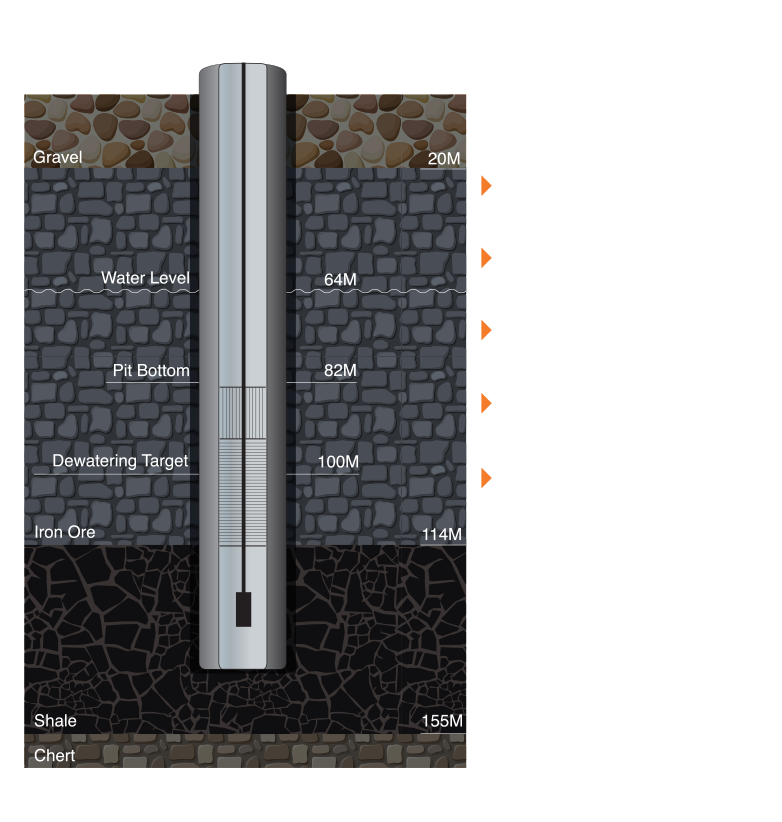OPERATING MINE
Februar 12, 2017
Unique drilling method used to develop water wells
Unique Water Well Drilling Method: Less than 1% hole deviation in first drill pass
OVERVIEW
Dual-tube flooded reverse circulation method develops water wells
Boart Longyear has multi-year contracts with the largest iron ore mining operations in the Pilbara region of northern Western Australia (WA) to undertake water well drilling at active and future mine sites.
The fleet of Boart Longyear dual-tube flooded reverse circulation (DTFR) water-well drill rigs have the ability to accommodate casing diameters of up to 28-inches, attain deep drill targets via a powerful 130,000-pound pullback and are mounted on a highly mobile platform. The rigs use a closed circulation mud system with a proprietary mud tank. By installing dewatering wells via DTFR, it is possible to control high producing aquifers during drilling that are problematic for conventional mud or conventional air drilling.
The DTFR method is distinguished from other drilling methods by the way the drill cuttings are returned to the surface through the drill string, whereas with conventional mud or air operations the cuttings are returned up the annulus.
The advantages of the DTFR method of circulation:
- Cutting return is quicker than a conventional mud method. Cuttings don’t co-mingle with the annulus, as with conventional drilling systems, eliminating contamination and reducing annular washouts or hole enlargement. Cutting return via the drill string means that mud loss will not stop drilling operations as long as the drill bit remains submerged. Circulation is almost never lost and drilling mud can be replaced during drilling without the need to stop.
- The mud system is a closed loop. Utilizing a special mud tank and drill cutting exchange, DTFR greatly reduces the drilling footprint compared to conventional mud drilling operations. Formation water is not an issue during drilling with almost zero discharge during drilling operations — making water management a non-issue.
- DTFR mud circulates in the annulus under ambient pressure conditions reducing development time. The residual mud is easily removed from the annulus wall during development. In addition to faster and more complete mud removal, the amount of discharge water managed at the surface is lessened due to the reduction in development time.
| Service | Drilling of in-pit and ex-pit dewatering and water supply wells |
| Location | Pilbara region of Western Australia |
| Application | Dual-tube Flooded Reverse (DTFR) Circulation |
Vital Stats
- Less than 1 percent hole deviation
- Single drill pass to reach target depth
- 2300 total meters were drilled in the Pilbara region
- Completed wells to depths of 250 meters and cased with 10- to 12-inch production strings

The Challenge
Reduce drilling and completion times, handle challenging ground conditions, reduce development time, manage discharge water in active mines and complete wells to target depths
The Boart Longyear DTFR drilling method was used to work in active mine sites in the Pilbara region — where there is a high volume of water discharged during drilling — without hindering active mining operations.
Historically, conventional air drilling or dual rotary drilling was used to set large diameter water supply, dewatering and injection wells. While these methods have the potential to drill quickly, maintaining circulation and hole integrity can be a challenge in fractured and friable ground conditions. As a result of circulation loss or collapsing, boreholes are often completed at shallower depths.
Drilling a large diameter hole with either conventional air or dual rotary air, can also produce a tremendous amount of discharge water. This is an issue because many drill locations cannot release water to the environment due to water quality issues. So, the water is contained in giant sumps dug parallel to the drill rig. Often these pits fill quickly during drilling and operations must be stopped to allow for draining. With DTFR the need for large sumps is eliminated because water is not discharged during drilling. This is a tremendous advantage working in-pit where water management issues can interrupt mining operations.
The Solution
A unique situation requires a unique drilling method
Over the period of a year, Boart Longyear drilled 2300 meters for a large mine operator in the Pilbara region with hole diameters of 17.5 and 20 inches. The completed wells reached depths of 250 meters and were cased with 10- to 12-inch production strings.
For the development of one ex-pit dewatering well in particular, the DTFR reached a depth of 144 meters with less than 1 percent of deviation during drilling.
Geology encountered included, banded iron, thick sequences of friable mineralized ore, and shale inter-bedded with hard chert bands. These changing ground conditions were easily handled by the DTFR and drilling did not stop at any point due to loss of circulation. Prior to the use of the DTFR in the Pilbara region, there was speculation that a tri-cone drill bit, which is typically used on all types of mud drilling, would not be able to handle the hard rocks associated with iron ore deposits. These concerns were quickly alleviated with DTFR, which helped persuade other large iron ore producers to sign multi-year contracts with Boart Longyear.
Want to know more? Learn more about Water Services





That’s interesting that after a discharge of water that cannot be released to the environment, the water is contained in giant sumps dug parallel to the drill rig. I’ve been looking into doing some bore water drilling on my property. Perhaps working with a professional company is the best option for me, despite wanting to work on it on my own.
Basically, as your article suggests, this DTFR method is more efficient and practical to do than the conventional mud method as the cuttings don’t co-mingle with the annulus. That sounds great since I am looking into having a water well installed in our backyard. Hopefully, I would be able to get a contractor that does this DTFR method so that I can see how great it is in action. Thanks!